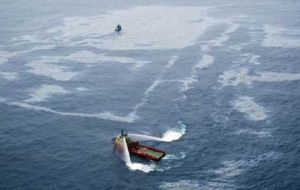MercoPress. South Atlantic News Agency
Chevron takes full responsibility for the oil spill offshore Brazil
 CEO George Buck. “We will share the lessons learned”
CEO George Buck. “We will share the lessons learned” Chevron promised to fully clean-up a spill off Brazil's coast, the CEO of the local subsidiary, George Buck, said on Sunday, taking responsibility for an accident that has become a major test for one of the world's fastest-growing oil frontiers.
The leak from the undersea well, owned in partnership with Brazil's state-controlled Petrobras and a Japanese consortium, has been plugged and the residual oil flow from undersea rock is now “more than 10 barrels,” but “less than hundreds of barrels” per day, Buck said.
“Chevron takes full responsibility for this incident,” Buck told reporters in Rio de Janeiro. “We will share the lessons learned here in the hope that this sort of incident won't happen again in Brazil or anywhere else in the world.”
The spill, one of the largest to hit Brazil's growing offshore oil industry has raised questions about its safety and ability to respond to accidents. Oil companies in Brazil are testing the limits of drilling as they seek oil at depths as much as 7 kilometres below the ocean surface, putting equipment and people under strains often compared with those for space flight.
The stakes are large. Brazilian oil companies expect to produce about 7 million barrels of oil per day by 2020, most of offshore near Rio de Janeiro, an amount that would make Brazil the third largest oil producer after Russia and Saudi Arabia.
Opposition to offshore drilling is growing worldwide in the wake of the estimated 4 million barrel BP Deepwater Horizon spill in the Gulf of Mexico in 2010. Brazil's Federal Police are probing the spill for possible criminal action.
Buck told a news conference that the spill was the result of an underestimate of pressure in the offshore oil reservoir being targeted. At the same time, the company overestimated the strength of undersea rock through which they were drilling.
As a result, high pressure oil was able to leak into the well borehole, overcoming a liquid sealant and well cleaning fluid known as “mud.” Because of the low pressure estimate, the mud was mixed “too light” to keep the oil under control.
While the well was immediately shut off, the pressure from the so-called “kick” as oil rushed up through the well mud bore-hole, or outside edge of the well structure, to crack. Oil then seeped through more than 500 meters of crevices and porous rock to the seafloor. From there, it bubbled more than a kilometre up to the ocean surface.
Chevron, which experienced the pressure “kick” on November 7, has come under criticism in Brazilian newspapers for failing to provide an immediate explanation for the spill and for a failure to provide a clear estimate of how much oil has leaked into the ocean.
The company, though, says the problem was brought under control within four days despite major transportation, weather, geological and environmental challenges.




Top Comments
Disclaimer & comment rules-

-

Read all commentsWhen one can no longer dodge the facts, harm can only be reduced by admitting to one's mistakes. There's nothing honest or noble in Chevron's admission. It is now admitting to its mismanagement - 10 days after the spill - because it can't avoid the facts anymore. Initially Chevron, represented by the idiotic Heloisa Marcondes, the subsidiary's press officer, even maintained that the spill was a natural phenomenon. Brazil's press has exerted zero pressure over Chevron to be more transparent regarding the oil spill, since it is, of course, much more interested in such vital questions as what kind was the plane which Minister Lupi used to travel to Maranhão, whether it was a “Sêneca” or a “King Air”.
Nov 21st, 2011 - 04:59 am 0“Chevron, . . . has come under criticism in Brazilian newspapers for failing to provide an immediate explanation for the spill and for a failure to provide a clear estimate of how much oil has leaked into the ocean.”
Nov 21st, 2011 - 08:06 pm 0and I have to repeat - it was not an oil 'spill'.
'Immediate explanation' - hardly surprising, until the facts were established geologically, technically and mathematically.
'Estimate of how much oil has leaked' - hardly surprising as it was a non-point-source seepage.
And the 'bad guys' in this purchased sector exploitation are Chevron Brasil, Petrobras, Transocean, and a Japanese consortium - which I cannot identify yet.
But surely the REAL bad guy is the bright young mathematician who researched the geophysical 3D data profiles and, from them, put a pressure factor into the algorithm that determined the 'mud' sealant density/viscosity characteristics.
Perhaps he should be dragged to trial in Brasil with a view to him spending the rest of his natural life in a Brasilian prison,
or perhaps he could be taken to the sector in chains by aeroplane and then, from a great height, thrown into the sheen that he was responsible for.
Commenting for this story is now closed.
If you have a Facebook account, become a fan and comment on our Facebook Page!